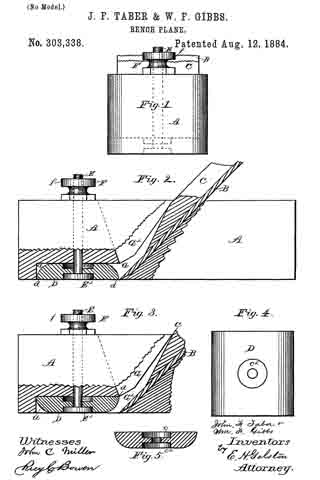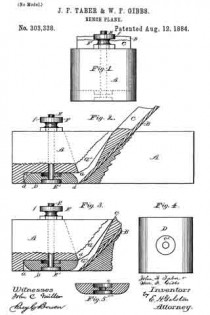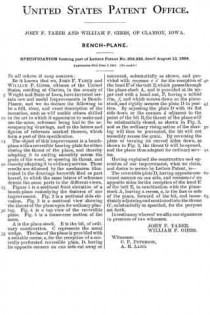No. 303,338 – Bench-Plane (John F. Taber And William F. Gibbs) (1884)

UNITED STATES PATENT OFFICE.
_________________
JOHN F. TABER AND WILLIAM F. GIBBS, OF CLARION, IOWA.
BENCH-PLANE.
_________________
SPECIFICATION forming part of Letters Patent No. 303,338, dated August 12, 1884.
Application filed June 3, 1884. (No model.)
_________________
To all whom it may concern:
Be it known that we, JOHN F. TABER. and WILLIAM F. GIBBS, citizens of the United States, residing at Clarion, in the county of Wright and State of Iowa, have lnvented certain new and useful Improvements in Bench-Planes; and we do declare the following to be a full, clear, and exact description of the invention, such as will enable others skilled in the art to which it appertains to make and use the same, reference being had to the accompanying drawings, and to the letters and figures of reference marked thereon, which form a part of this specification.
The object of this improvement is a bench-plane with a reversible bearing-plate for either closing the throat of the plane, and thereby adapting it to cutting smoothly across the grain of the wood, or opening its throat, and thereby adapting it to ordinary service. These results are attained by the mechanism illustrated in the drawings herewith filed as part hereof, in which the same letters of reference denote the same parts in the different views.
Figure 1 is a sectional front elevation of a bench-plane embodying the features of our improvement. Fig. 2 is a sectional side elevation. Fig. 3 is a sectional view showing the throat of the plane open for ordinary planing. Fig. ft is a top view of the reversible plate. Fig. 5 is a transverse section of the same.
A is the plane-stock. B is the bit, of ordinary construction. C represents the usual wedge. The face of the plane is provided with a suitable recess, a, for the reception of a centrally-perforated reversible plate, D, having its opposite corners on one side cut away or converted, substantially as shown, and provided with recesses c c’ for the reception of the head E’ of the bolt E, which passes through the plane-stock A, and is provided at its upper end with a hand-nut, F, having a milled rim, f, and which screws down on the plane-stock, and rigidly secures the plate D in position. By adjusting the plate D with its flat side down or the corners d adjacent to the point of the bit B, the throat of the plane will be substantially closed, as shown in Fig. 2, and as the ordinary rising action of the shaving will thus be prevented, the bit will cut smoothly across the grain. By reversing the plate or turning its curved sides down, as shown in Fig. 3, the throat G will be opened, and the plane thus adapted for ordinary service.
Having explained the construction and operation of our improvement, what we claim, and desire to secure by Letters Patent, is —
The reversible plate D, having opposite convexed corners on one side, and recesses c c’ on opposite sides for the reception of the head E’ of the bolt E, in combination with the plane-stock A, leaving a recess, a, in the face or sole of the plane, forward of the bit, and immediately adjoining and continued into the throat G’ substantially as specified, for the purpose set forth.
In testimony whereof we affix our signatures in presence of two witnesses.
JOHN F. TABER.
WILLIAM F. GIBBS.
Witnesses:
C. F. PETERSON,
A. R. LADD.


